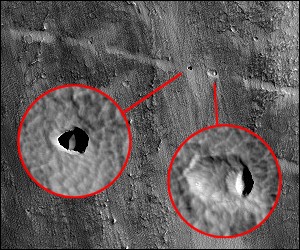Extraterrestrial Caves
The Search for Life in the Universe
ET LavatubesNIAC StudyThe Caves of Mars
Lavatube Caves On Other Planets
 On other planets, lavatubes appear to also exist (e.g. Oberbeck et al., 1969; Greeley, 1969, 1994; Grin et al., 1998; Boston, 2004; Cushing et al., 2007). On Mars, caves that are visible with current orbital missions are of volcanic origin. Mars seems to be particularly rich with tubes. The morphological evidence of lava tubes can be seen easily in orbital images where the strings of collapse features near the tube ends are clearly visible (Boston, 2004; Cushing et al., 2007). These strings of Martian lava tubes radiate out from central volcanic sources, as we see them on Earth. The properties and structure of such features depend upon the basic physical conditions within which they form. The most obvious difference between Earth and Mars is the gravitational situation. Scaling for Mars simply on the basis of gravity, lava tubes can grow perhaps two to two and a half times the size that they can on Earth and this typical size difference is quite visible in orbital images from various Mars missions. However, this rule of thumb is probably modified by considerations of the inherent load-bearing strengths of the basalts, andesites, or other lava materials involved. On the other hand, the lower gravity causes less trenching erosion to occur thus probably preventing some of the types of tubes that we find on Earth, especially those that significantly erode pre-existing channel as they form. The positioning of these tubes with respect to depth on Mars and the moon may be less than that of Earth simply because of the lesser downward force exerted by the eroding lava stream.
On other planets, lavatubes appear to also exist (e.g. Oberbeck et al., 1969; Greeley, 1969, 1994; Grin et al., 1998; Boston, 2004; Cushing et al., 2007). On Mars, caves that are visible with current orbital missions are of volcanic origin. Mars seems to be particularly rich with tubes. The morphological evidence of lava tubes can be seen easily in orbital images where the strings of collapse features near the tube ends are clearly visible (Boston, 2004; Cushing et al., 2007). These strings of Martian lava tubes radiate out from central volcanic sources, as we see them on Earth. The properties and structure of such features depend upon the basic physical conditions within which they form. The most obvious difference between Earth and Mars is the gravitational situation. Scaling for Mars simply on the basis of gravity, lava tubes can grow perhaps two to two and a half times the size that they can on Earth and this typical size difference is quite visible in orbital images from various Mars missions. However, this rule of thumb is probably modified by considerations of the inherent load-bearing strengths of the basalts, andesites, or other lava materials involved. On the other hand, the lower gravity causes less trenching erosion to occur thus probably preventing some of the types of tubes that we find on Earth, especially those that significantly erode pre-existing channel as they form. The positioning of these tubes with respect to depth on Mars and the moon may be less than that of Earth simply because of the lesser downward force exerted by the eroding lava stream.
With all the truly compelling sites on Mars that have been championed as the "best" sites for scientific investigation, lavatube caves offer particular and special features. Here on Earth it is clear that there is an amazing diversity of shapes, forms, biology, mineralogy, chemistry and formation mechanism of lavatubes (Boston, 2004, et al., 2001; Northup and Lavoie, 2001; Northup et al., 2004). We have suggested that the subsurface of Mars, including caves, may have been the last refuge for life on that planet as the climate on the surface became ever less hospitable (Boston et al., 1992). In addition, the use of lavatubes on the Moon and Mars as future habitat for human explorers and colonists has been advanced (Boston, 2000, et al., 2004).
(Inset Image courtesy NASA HiRISE Mars Orbiter,Frame No. ESP_014380_1775, "Possible Skylight on a Lava Tube Northeast of Arsia Mons"21 August 2009)


